THINGS TO DO IN KRAKOW
Sightseeing, Activities, Transfers and What Not2024 Krakow Travel Guide
Customer reviews
Trustrank 4.8/5 based on 12+ customer reviews.
Free Cancellation. Stag goes Free (12+)
94% of our guests say we're surprisingly awesome!
STRESS-FREE
Check prices online and secure dates now. No obligations.
FULLY PRIVATE YET FRIENDLY - PRICED
All our activities are private. We do not join groups.
SAFE
Est. in 2006 under EU law. Secure online payments.
FLEXIBLE
Friendly support, no small print, flexible terms. Dedicated teams of local heroes
KRAKOW SIGHTSEEING
Krakow, also spelled "Kraków" or "Cracow", is a historic city located in southern Poland. It is the second-largest city in the country and has a rich history dating back over a thousand years. Here's an overview of the location, history, and some trivia about Krakow:
Location
Krakow is situated in the Lesser Poland region, on the banks of the Vistula River. It is approximately 250 kilometres (155 miles) south of Poland's capital, Warsaw. The city lies at the foot of the Carpathian Mountains, near the border with the Czech Republic and Slovakia.
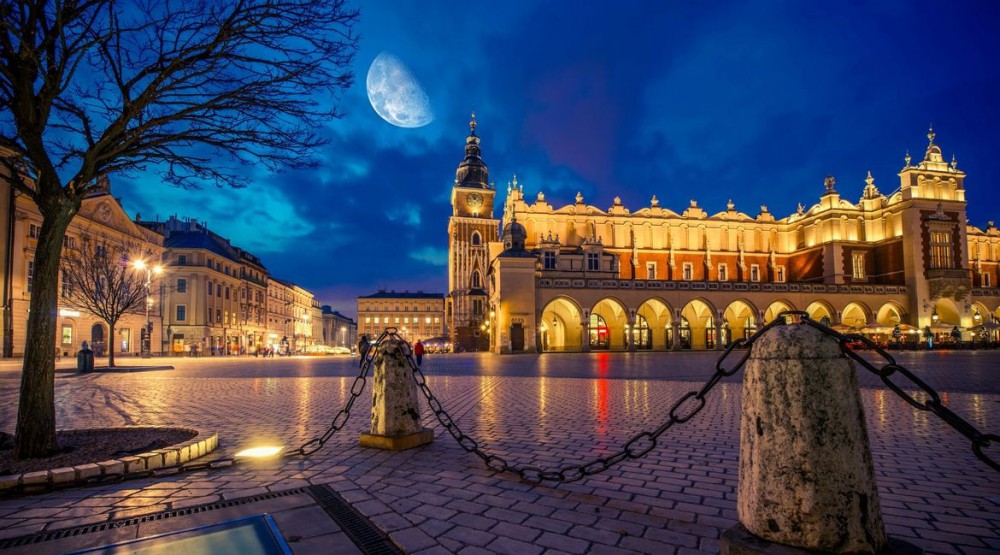
History
1. Early History: Krakow's origins can be traced back to the 7th century when it was established as a settlement by the Slavic tribe of Vistulans. It quickly grew into a trading center and became the capital of Poland in the 11th century.
2. Royal Capital: During the Middle Ages, Krakow thrived as a royal capital and an important cultural and intellectual center. It was the residence of Polish kings and the seat of the Polish Parliament (Sejm). The city's architectural heritage reflects its prosperous past.
3. Renaissance and Baroque Influences: In the 16th century, Krakow experienced a period of Renaissance and Baroque architectural development. Many magnificent buildings were constructed during this time, including the Royal Castle, St. Mary's Basilica, and the Cloth Hall.
4. Partitions of Poland: In the late 18th century, Poland faced a series of partitions by neighboring powers, leading to its disappearance from the map of Europe. Krakow became part of the Austrian Empire in 1795 and remained under Austrian rule until 1918.
5. Polish Independence: After World War I, Poland regained its independence, and Krakow became part of the newly reestablished Polish Republic. However, in the early years, Warsaw served as the capital, while Krakow retained its cultural and historical significance.
6. World War II: During World War II, Krakow was occupied by Nazi Germany. The city's Jewish population suffered greatly during the Holocaust, with the Nazis establishing the Krakow Ghetto and deporting thousands to concentration camps. The nearby Auschwitz-Birkenau concentration camp complex became a symbol of the Holocaust.
7. Modern Era: Since the end of World War II, Krakow has undergone significant urban development and has become a major center for culture, tourism, and education in Poland. It was designated a UNESCO World Heritage Site in 1978.
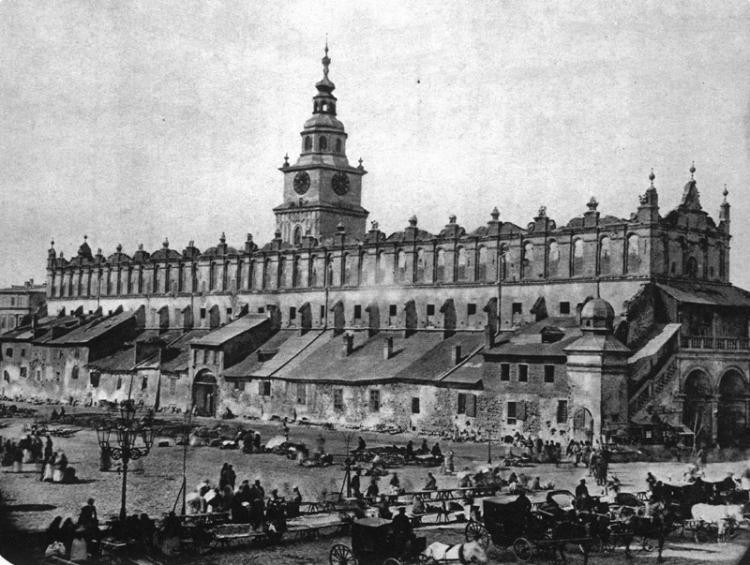
Trivia
1. Wawel Castle: Wawel Castle, located in Krakow, served as the residence of Polish kings for centuries. It is a remarkable architectural complex that includes a cathedral and a collection of historic art and artifacts.
2. Dragon Legend: Krakow is associated with the legend of the Wawel Dragon. According to folklore, the mythical dragon lived in a cave beneath Wawel Hill and was eventually defeated by a clever shoemaker's apprentice.
3. Copernicus' Studies: The renowned astronomer Nicolaus Copernicus, known for formulating the heliocentric theory of the solar system, studied at the University of Krakow in the late 15th century.
4. Underground Tunnels: Krakow has an extensive network of underground tunnels, known as the Krakow Underground, which were used for various purposes throughout history, including defense, commerce, and storage.
5. Festival of St. John: Each year, on June 24th, Krakow celebrates the Festival of St. John (Wianki), featuring music, dancing, and the floating of wreaths on the Vistula River.
Krakow's long and storied history, combined with its architectural beauty and cultural heritage, make it a captivating destination for visitors from around the world.

When visiting Kraków, there are several top sights and attractions worth exploring. Here are some of the best things to see:
TOP 24 THINGS TO SEE IN KRAKOW
1. Wawel Castle and Wawel Hill
Wawel Castle is a historic castle complex situated on Wawel Hill, overlooking the Vistula River. It served as the residence of Polish kings and queens for centuries. Visitors can explore the castle's royal chambers, which showcase opulent decor, artwork, and historical artifacts. The Wawel Cathedral, located within the castle complex, is a magnificent Gothic cathedral where Polish monarchs were crowned and buried. The cathedral houses stunning chapels, tombs, and works of art, including the famous Sigismund Bell. From Wawel Hill, visitors can enjoy panoramic views of Kraków, the river, and the surrounding landscape.
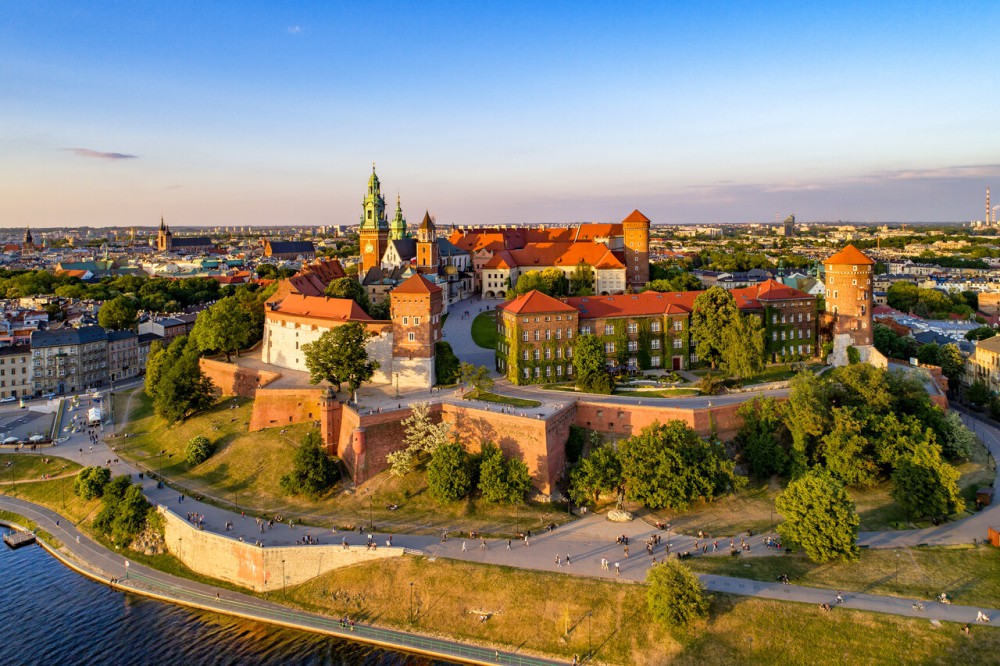
2. Kraków's Old Town (Stare Miasto)
Kraków's Old Town is a UNESCO World Heritage site and is known for its well-preserved medieval architecture, charming streets, and vibrant atmosphere. The Main Market Square (Rynek Główny) is the centerpiece of the Old Town and is the largest medieval square in Europe. It is surrounded by stunning buildings, including the iconic St. Mary's Basilica with its breathtaking Gothic architecture and famous altar. The Cloth Hall (Sukiennice) in the square is a historic marketplace where you can find traditional crafts and souvenirs. The Rynek Underground Museum provides an immersive experience where visitors can explore the underground history of Kraków through interactive exhibitions and excavated remains.
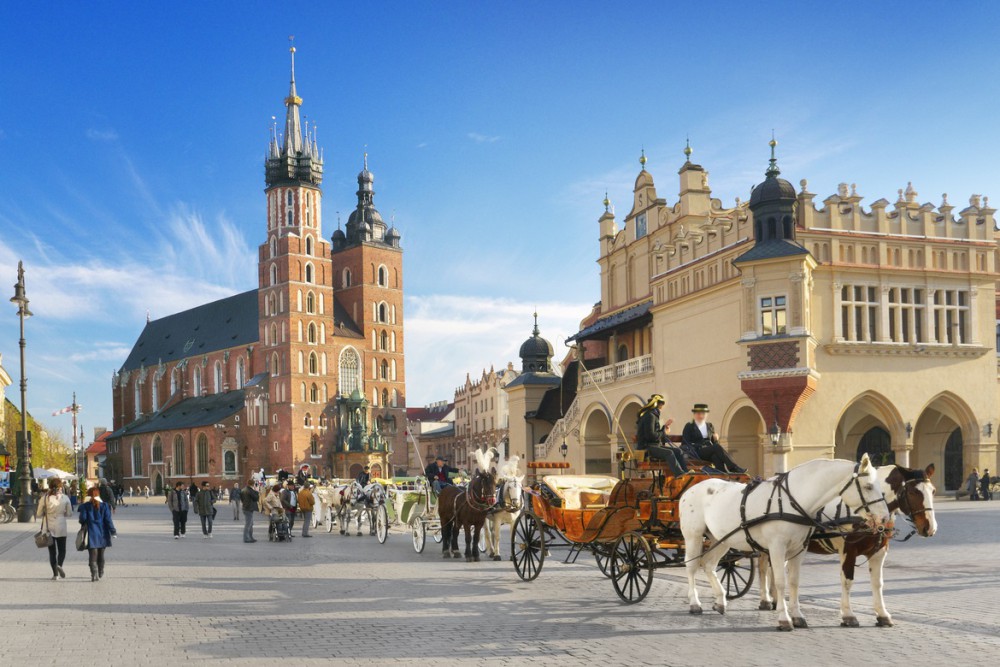
3. Main Market Square (Rynek Główny)
The Main Market Square, also known as Rynek Główny, is the central square in Kraków's Old Town and is one of the largest medieval squares in Europe. It covers an area of around 40,000 square meters and is a bustling hub of activity. Surrounded by stunning buildings, the square serves as a focal point for both locals and tourists. The Main Market Square is a vibrant and lively place, with numerous cafes, restaurants, and shops lining its perimeter. The square is a popular gathering spot and often hosts various events, markets, and festivals throughout the year. It is a perfect place for people-watching, relaxing, and immersing oneself in the city's vibrant atmosphere.
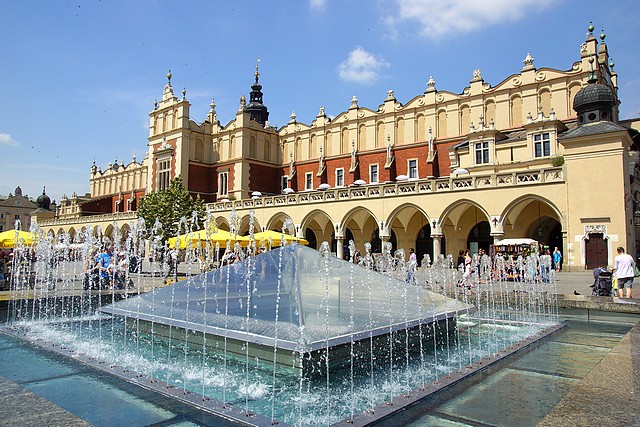
4. St. Mary's Basilica
Located on the square's eastern side, St. Mary's Basilica (Kościół Mariacki) is an architectural masterpiece and one of the most recognizable symbols of Kraków. Its stunning Gothic facade features intricate ornamentation and delicate details. The highlight of the church is its famous altar, a magnificent wooden masterpiece carved by Veit Stoss. Visitors can enter the basilica to admire its interior, which is adorned with beautiful stained glass windows and intricate decor.

5. Rynek Underground Museum
Situated beneath the Main Market Square is the Rynek Underground Museum, a unique attraction that takes visitors on a journey through Kraków's underground history. The museum offers a glimpse into the past through interactive exhibitions, archaeological artifacts, and excavated remains. Visitors can explore the underground chambers and corridors that were once part of the medieval city, discovering the stories of Kraków's inhabitants, trade, and daily life. The exhibits use multimedia presentations, visual effects, and reconstructions to bring the history of the city to life. The Rynek Underground Museum provides a fascinating and immersive experience for those interested in the history and heritage of Kraków.
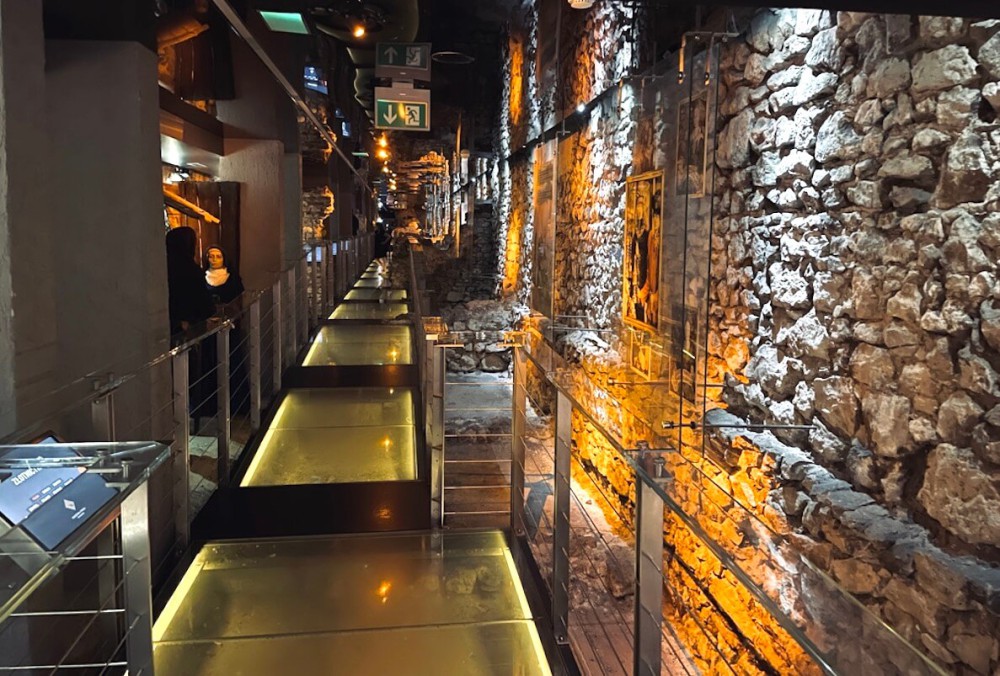
6. Kazimierz District
The Kazimierz District is the historic Jewish quarter of Kraków and is known for its rich cultural heritage. It features atmospheric streets, historic synagogues, and a vibrant arts and culinary scene. Visitors can explore the charming cafés, restaurants, and boutique shops that line the streets. The district is home to significant sites like the Old Synagogue, one of the oldest synagogues in Poland, and the Remuh Synagogue with its adjacent cemetery.

7. Schindler's Factory Museum
Housed in the former enamel factory of Oskar Schindler, the Schindler's Factory Museum offers a profound insight into the history of Kraków during World War II. The museum tells the story of Oskar Schindler and his efforts to save over a thousand Jewish lives. Through multimedia exhibitions, artifacts, and personal accounts, visitors can learn about the experiences of Kraków's residents during the Nazi occupation.
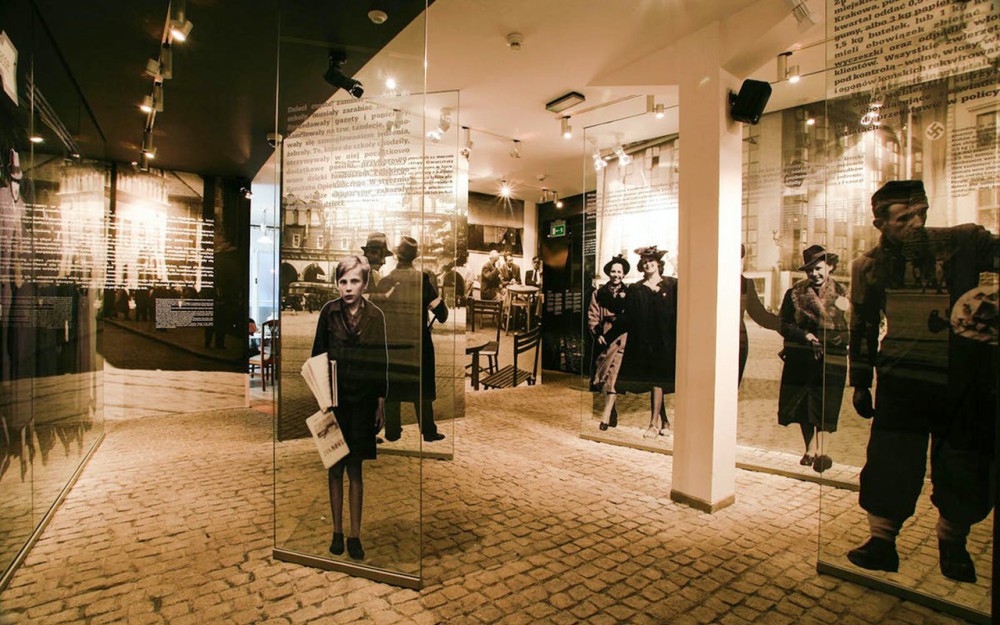
8. Auschwitz-Birkenau Memorial and Museum
While not located in Kraków itself, the Auschwitz-Birkenau Memorial and Museum is a significant historical site located nearby and is an essential visit for its historical importance. It is a former Nazi concentration and extermination camp where millions of people, mostly Jews, were systematically murdered during the Holocaust. The memorial and museum offer a somber and educational experience, providing insights into the atrocities committed and honouring the memory of the victims.

9. Planty Park
Planty Park is a beautiful green space that encircles the Old Town of Kraków. It was created in the 19th century when the city's medieval fortifications were dismantled. The park offers a peaceful retreat from the bustling city streets and provides a serene environment with tree-lined paths, flower gardens, and charming benches. Visitors can take a leisurely stroll or rent a bike to explore the park's winding paths and enjoy the picturesque scenery. Planty Park is an ideal place to relax, have a picnic, or simply unwind while admiring the historic buildings that border the park.
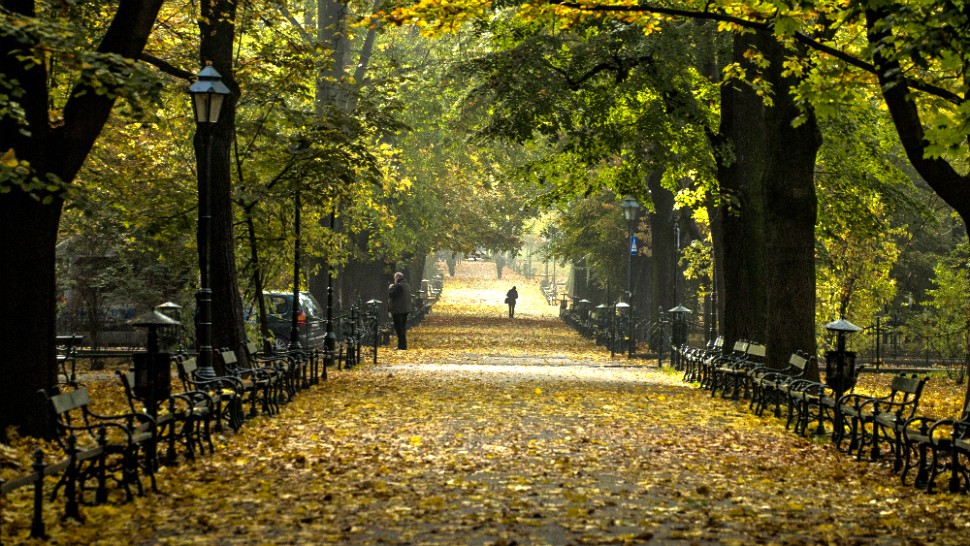
10. Wieliczka Salt Mine
Located just outside of Kraków, the Wieliczka Salt Mine is a remarkable underground attraction that has been in operation for over 700 years. It is one of the oldest salt mines in the world and a UNESCO World Heritage site. Visitors can take guided tours through the mine and explore its stunning chambers, chapels, and underground lakes, all carved out of salt. The mine is famous for its intricate salt sculptures and salt chandeliers, created by the miners themselves. It offers a unique and awe-inspiring experience that showcases the history and significance of the salt mining industry in the region.
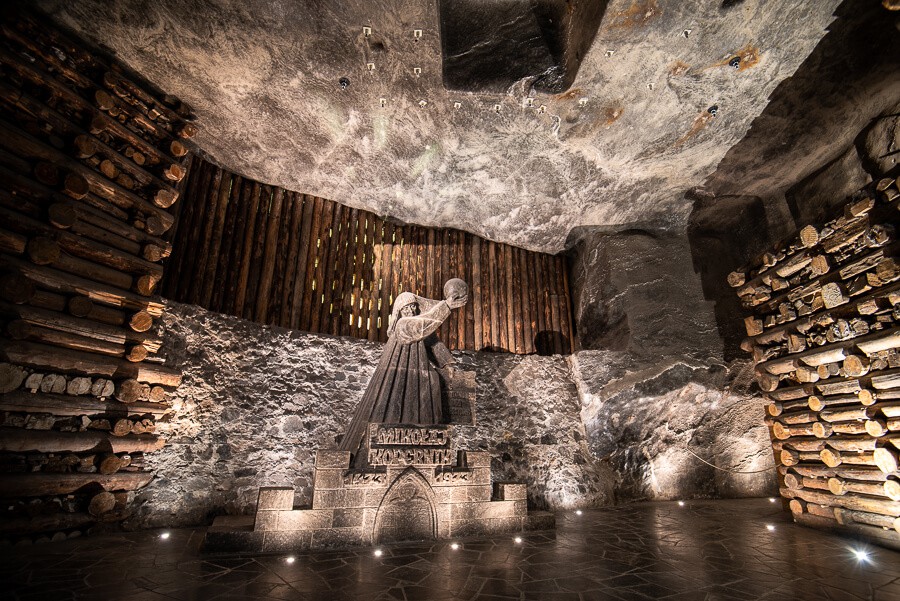
11. Kościuszko Mound
Kościuszko Mound is a man-made hill located on the outskirts of Kraków. It was built in the early 19th century to honor Tadeusz Kościuszko, a Polish national hero who fought for independence and equality. Visitors can climb to the top of the mound, which offers panoramic views of Kraków and the surrounding countryside. Inside the mound, there is a small exhibition dedicated to the life and achievements of Kościuszko. It's a popular spot for both locals and tourists to enjoy the scenery and appreciate the historical significance of the site.

12. Collegium Maius
Collegium Maius is the oldest building of the Jagiellonian University, one of the oldest universities in the world. It dates back to the 14th century and is an architectural treasure of Kraków. Visitors can take guided tours of the building to explore its historic halls, admire the intricate courtyard with its Renaissance arcades, and see the famous astronomical clock, known as the Orloj. The tour provides insight into the rich academic legacy of the university and the important role it has played in Polish intellectual and cultural history.
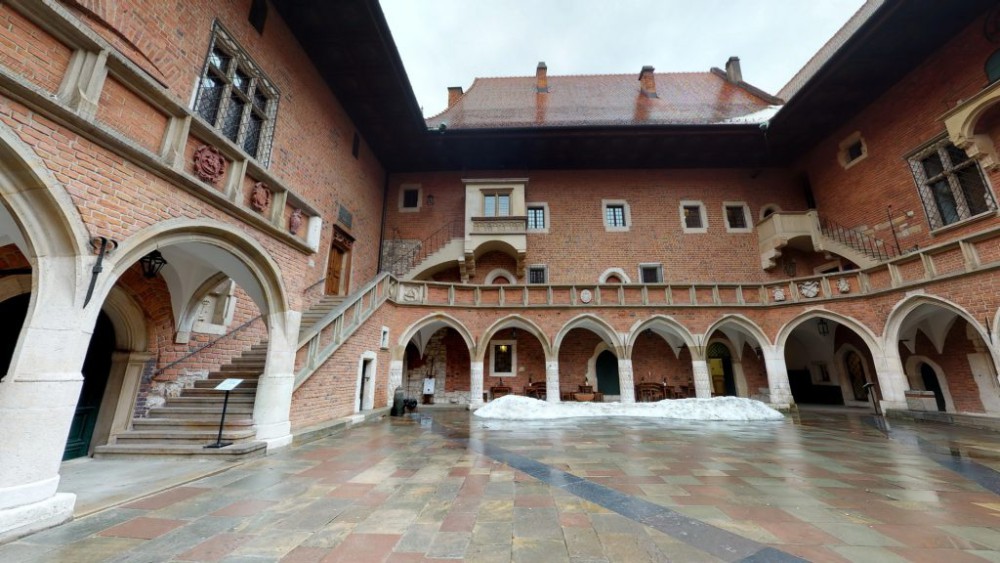
13. Museum of Contemporary Art in Kraków (MOCAK)
If you have an interest in modern art, a visit to the Museum of Contemporary Art in Kraków (MOCAK) is highly recommended. The museum showcases a diverse collection of contemporary artworks from Polish and international artists. It hosts thought-provoking exhibitions, installations, and multimedia presentations that explore various themes and perspectives. MOCAK aims to engage visitors and stimulate dialogue on social, cultural, and political issues through contemporary artistic expression. It is a dynamic and vibrant cultural institution that offers a fresh and contemporary perspective on art.

14. Nowa Huta
Nowa Huta is a district of Kraków that represents a unique chapter in the city's history. It was built in the 1950s as a model socialist realist industrial town. Nowa Huta was planned to be a showcase of communist ideals, with monumental architecture, wide avenues, and a central square. Visitors can take guided tours to learn about the history, architecture, and daily life in this former industrial area. Highlights include a visit to the Central Square, which features the impressive steelworks-inspired Centralny Dom Handlowy building, and experiencing the distinctive atmosphere of this neighborhood that bears the legacy of its socialist past.
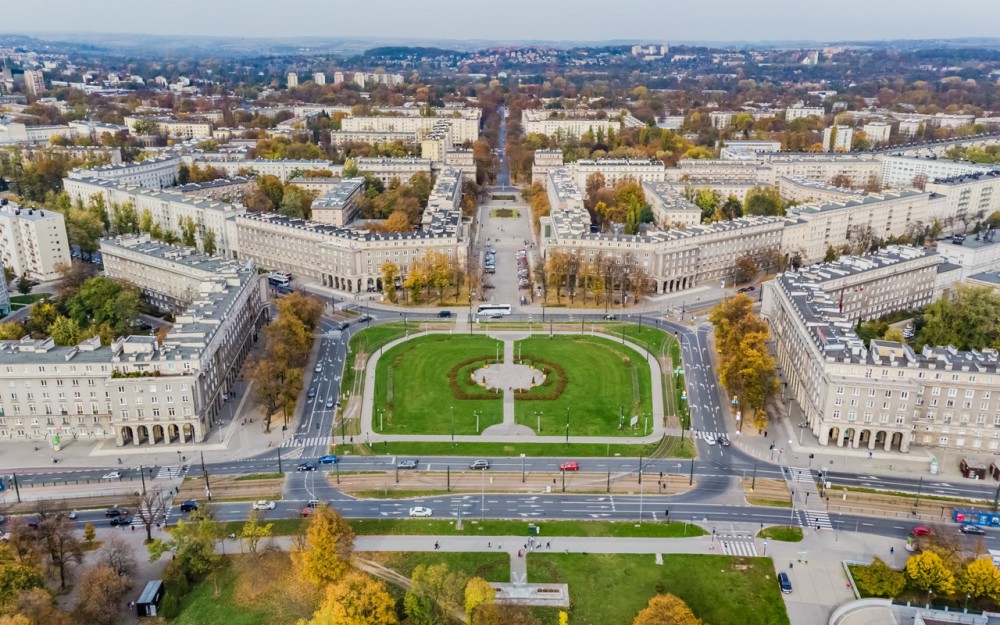
15. Kraków Barbican
The Kraków Barbican is a medieval fortification that once served as a defensive gateway to the city. It is one of the best-preserved examples of such fortifications in Europe. Built in the 15th century, the Barbican is a circular structure with massive walls and seven turrets. Visitors can take a walk along the ramparts, climb the towers, and learn about Kraków's fortifications and defensive history. The Barbican is a significant historical landmark and provides a glimpse into the city's medieval past.
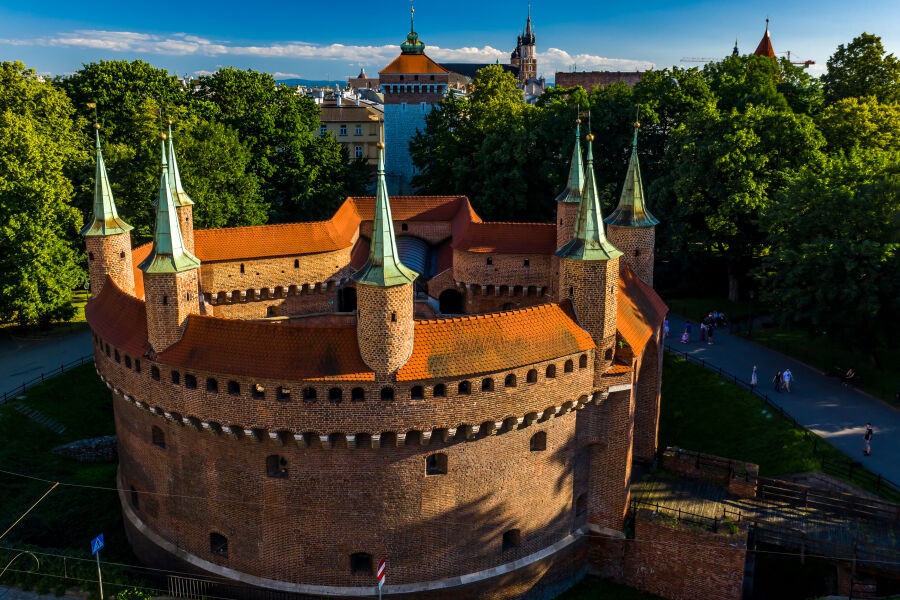
16. Jagiellonian University
The Jagiellonian University is one of the oldest universities in the world, founded in 1364. It has a rich academic tradition and has been a center of learning and intellectual pursuit for centuries. Visitors can take guided tours of the university to explore its impressive architecture and historic buildings. The Collegium Novum building, with its grand facade and ornate interiors, is particularly noteworthy. The university has been associated with renowned scholars, including Copernicus and Pope John Paul II, and continues to be a leading educational institution in Poland.
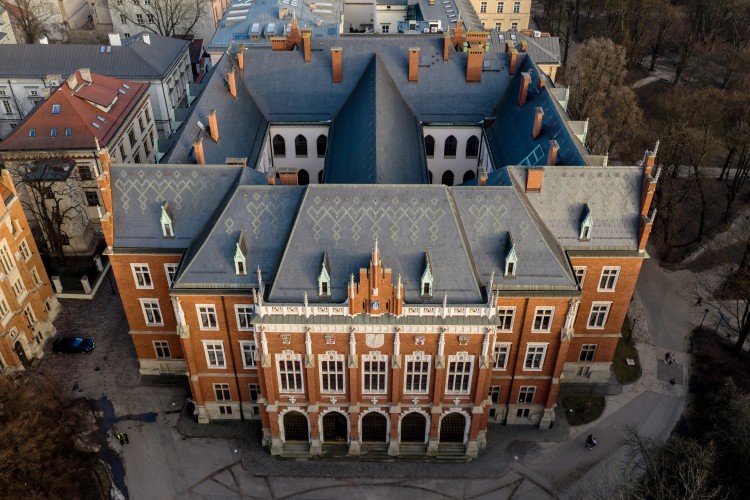
17. Galicia Jewish Museum
The Galicia Jewish Museum is dedicated to preserving and promoting the history and culture of Kraków's Jewish community. Through thought-provoking exhibitions, multimedia presentations, and archival materials, the museum provides insights into Jewish heritage, history, and contemporary issues. Visitors can learn about the vibrant Jewish life that once thrived in Kraków's Kazimierz District, as well as the tragic events of the Holocaust. The museum aims to foster dialogue and understanding, making it a significant cultural institution in Kraków.

18. Tyniec Abbey
Tyniec Abbey is a Benedictine monastery located on a picturesque hill overlooking the Vistula River. It has a history dating back over 900 years and offers a tranquil and serene atmosphere. Visitors can explore the historic complex, visit the abbey church with its beautiful interior, and admire the views from the hilltop. The abbey also has a museum that showcases artifacts related to its history and religious life. Tyniec Abbey is a popular destination for those seeking a peaceful retreat and a glimpse into monastic life.

19. Krakus Mound
Krakus Mound is an artificial hill located in the Podgórze district of Kraków. Legend has it that it serves as the burial site of King Krakus, the mythical founder of Kraków. Visitors can climb to the top of the mound, which offers panoramic views of the city, including the Old Town and the Tatra Mountains in the distance. It's a popular spot for locals and tourists alike, providing a peaceful setting to enjoy the scenery and learn about the legends and folklore associated with Kraków's origins.
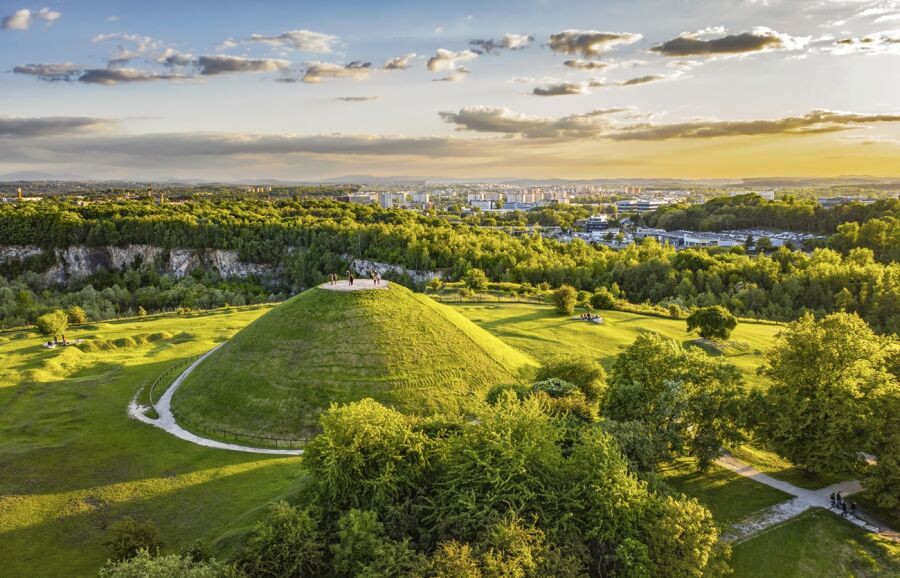
20. National Museum in Kraków
The National Museum in Kraków is the largest museum institution in Poland, encompassing various branches and collections. It houses extensive collections of art, archaeology, history, and numismatics. Visitors can explore a wide range of exhibits, from Renaissance masterpieces to contemporary artworks, as well as archaeological artifacts and historical objects that showcase Poland's rich cultural heritage. The museum provides a comprehensive overview of Polish art and history, making it a valuable cultural resource in Kraków.
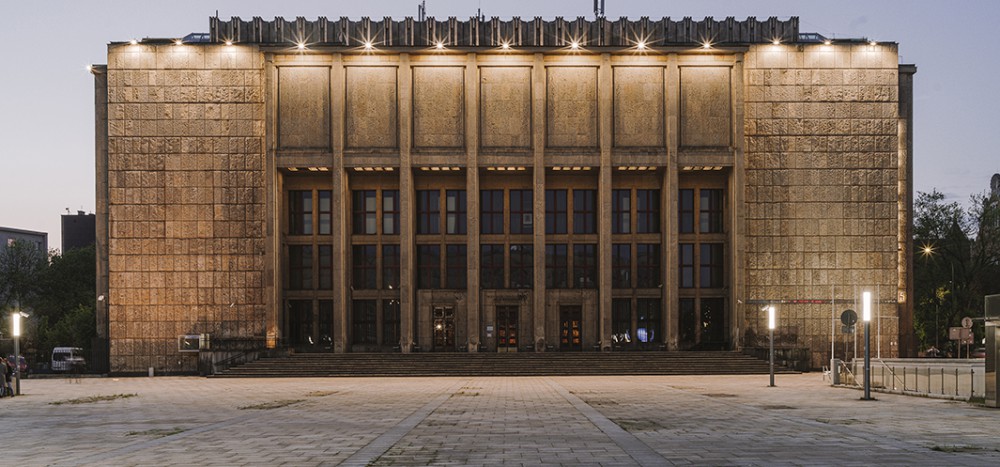
21. Czartoryski Museum
The Czartoryski Museum is known for its remarkable collection of European art, including the famous painting "Lady with an Ermine" by Leonardo da Vinci. The museum showcases a diverse range of artworks from different periods and artistic movements, offering visitors the opportunity to appreciate classical art in an intimate setting. It also houses other masterpieces, such as works by Rembrandt and Raphael. The Czartoryski Museum allows visitors to immerse themselves in the world of classical art and explore the museum's elegant interiors.
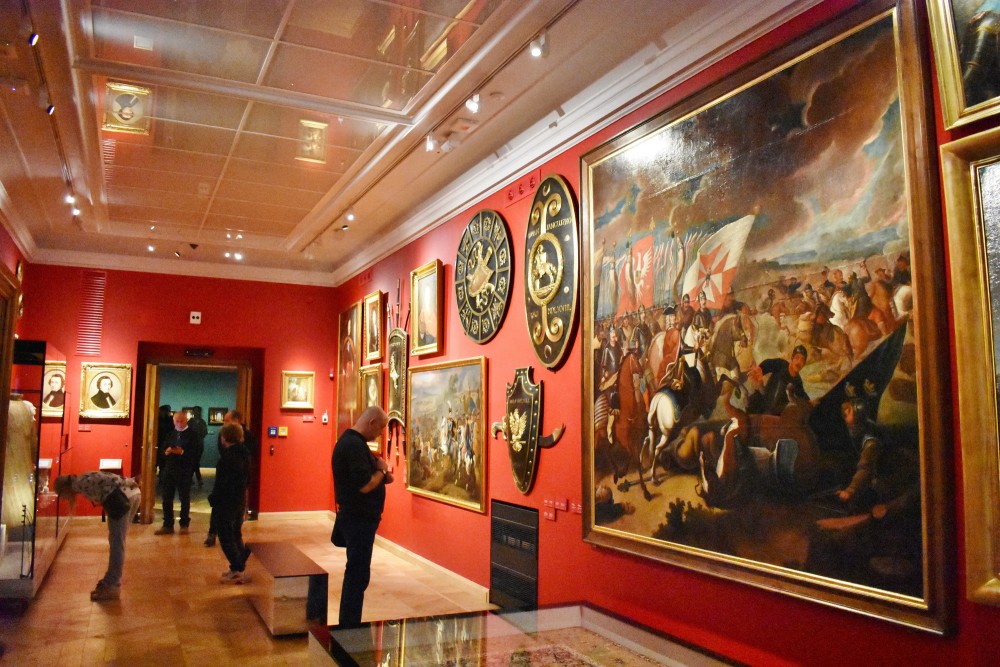
22. St. Florian's Gate
St. Florian's Gate is an iconic symbol of Kraków's historical fortifications. It is one of the best-preserved medieval gateways in Europe and marks the entrance to the Old Town. The gate features a distinctive tower and an ornate facade. Walking through the gate is like stepping back in time, as it offers a glimpse into the city's medieval past. St. Florian's Gate is an important architectural landmark and a popular spot for taking photographs and enjoying the vibrant atmosphere of the city.
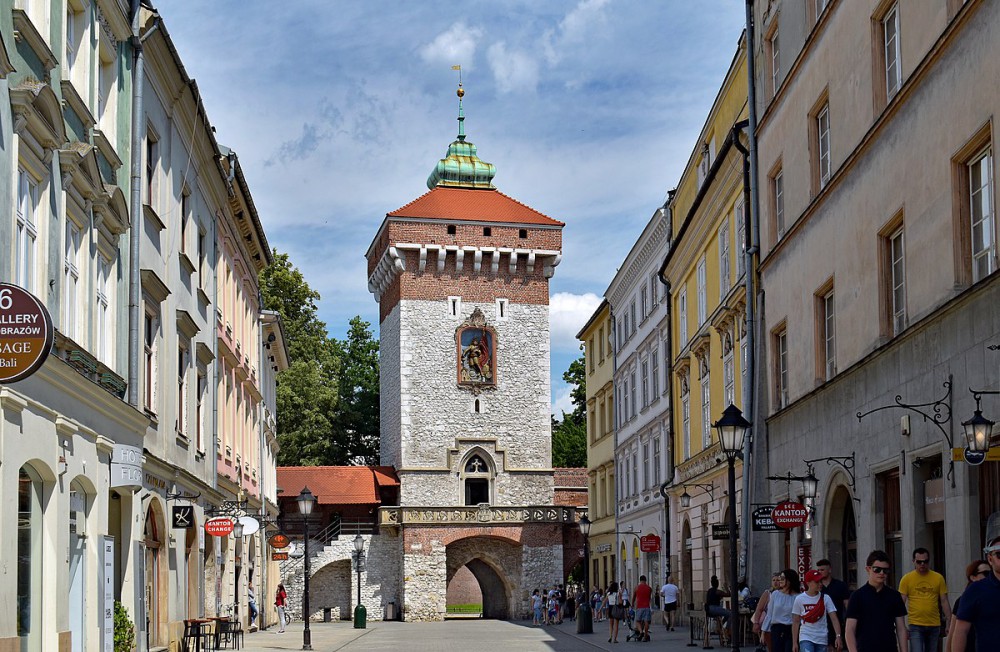
23. Manggha Museum of Japanese Art and Technology
The Manggha Museum celebrates the beauty and intricacy of Japanese art and culture. It features a wide range of exhibitions, including traditional Japanese paintings, ceramics, calligraphy, and contemporary art. The museum explores the dynamic connection between Japan and Poland, showcasing the influence of Japanese aesthetics and philosophy on Polish artists. Visitors can immerse themselves in the world of Japanese art and technology through multimedia presentations, workshops, and cultural events held at the museum.
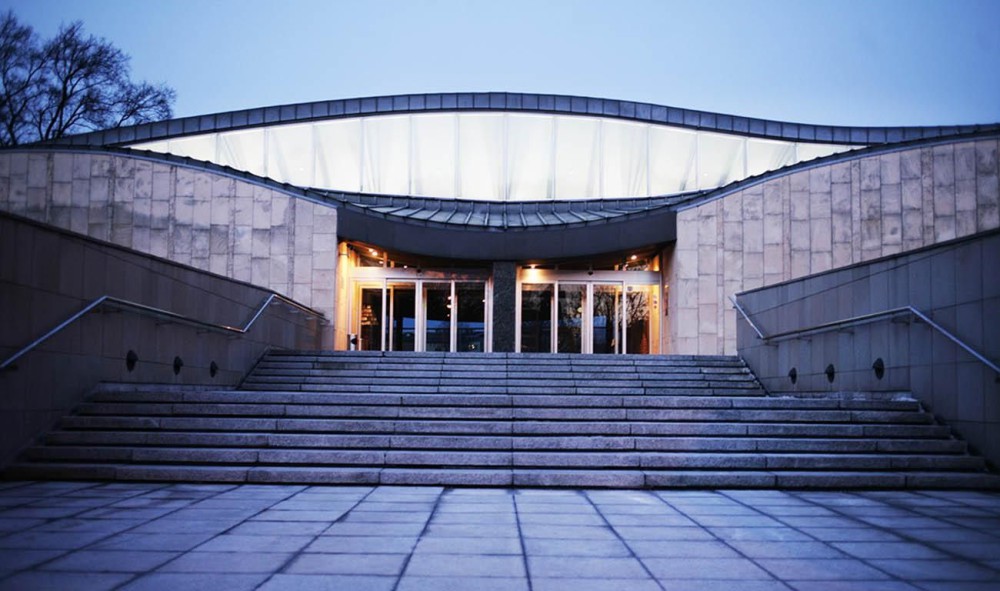
24. Juliusz Słowacki Theatre
The Juliusz Słowacki Theatre is a historic theatre located in the heart of Kraków. Known for its stunning architecture and rich theatrical heritage, the theatre hosts a variety of performances, including plays, operas, ballets, and concerts. The repertoire includes both classical works and contemporary productions, offering a diverse cultural experience. The theatre's interior features elegant decor and a grand auditorium, providing a splendid setting for artistic performances. Attending a show at the Juliusz Słowacki Theatre is an excellent way to immerse oneself in Kraków's vibrant arts scene.
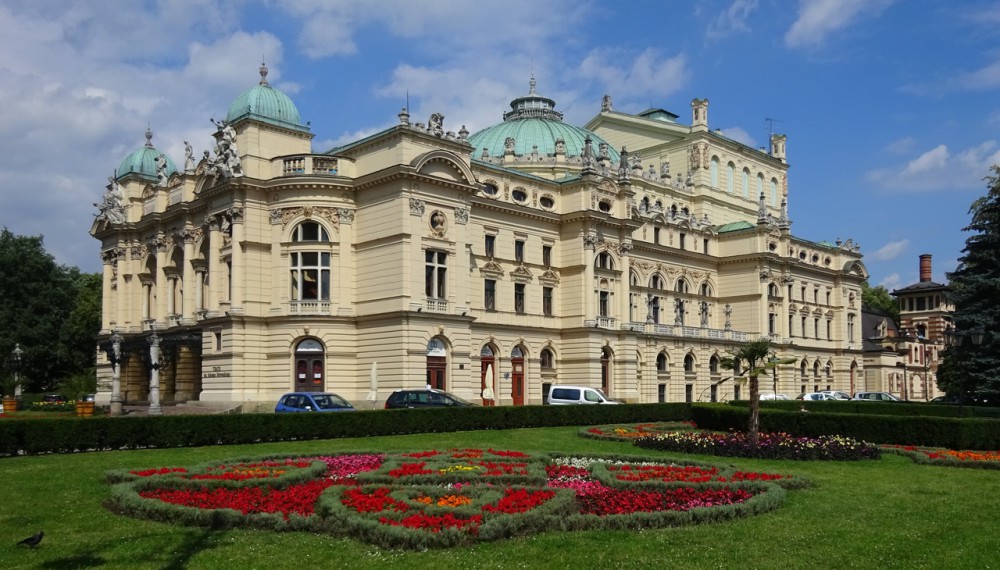
YOUR ACTIVITIES / AIRPORT TRANSFERS
Book the dates without obligation
WE BOOK IT FOR YOU
Time to talk to your friends
PAY DEPOSIT TO CONFIRM
Rest is due only when you arrive
MEET YOUR GUIDE AT THE AIRPORT
Hop on airport transfer
ENJOY ACTIVITIES IN KRAKOW
Day, night, team-building... you name it, we have it
TRANSFER BACK TO THE AIRPORT
Private minivan, limousine, party bus?
KRAKOW RESTAURANTS
Kraków has been experiencing a culinary renaissance, with a focus on preserving traditional Polish flavours while also embracing innovation and modern techniques. Local chefs and restaurateurs have been incorporating high-quality, locally sourced ingredients and reinterpreting traditional recipes with a contemporary twist.
There has been an increased emphasis on farm-to-table dining, with a growing number of restaurants highlighting regional and seasonal ingredients. Many chefs are collaborating with local farmers, artisans, and producers to create dishes that showcase the best of Kraków's culinary offerings.
Furthermore, there has been a rising interest in promoting sustainable and eco-friendly practices within the food industry. Restaurants are increasingly incorporating organic and locally sourced ingredients, reducing food waste, and implementing environmentally conscious practices.
Kraków's dining scene continues to cater to a wide range of tastes and preferences, with a diverse array of international cuisines represented alongside traditional Polish fare. Whether you're seeking classic Polish dishes, Jewish specialties, or international flavors, you can find a variety of options to suit your culinary preferences in Kraków.

Krakow hosts various culinary events throughout the year, celebrating the city's vibrant food scene and offering opportunities to explore Polish and international cuisines. While I can provide information on some notable culinary events that have taken place in Krakow, please note that event schedules can change, and it's always a good idea to check the latest updates and specific dates for upcoming events. Here are a few culinary events that have been held in Krakow:
1. Krakow Ice Cream Festival: This annual event celebrates the sweet indulgence of ice cream. Local and international ice cream vendors gather to showcase their creations, offering a wide range of flavors and styles. The festival features tastings, workshops, and various ice cream-related activities.
2. Krakow Pierogi Festival: Pierogi, the beloved Polish dumplings, take the spotlight at this festival. Held in the heart of Krakow, the event brings together numerous vendors who serve up a variety of pierogi fillings and styles. Visitors can enjoy tastings, participate in cooking workshops, and learn more about the history and techniques behind making pierogi.
3. Krakow Wine & Food Festival: This event is dedicated to the appreciation of wine and gourmet food. It showcases a selection of wines from around the world, complemented by food offerings from local restaurants and culinary artisans. The festival includes tastings, food and wine pairings, seminars, and chef demonstrations.
4. Krakow Street Food Festival: Street food enthusiasts gather at this festival to experience a wide range of global flavors. The event features food trucks, stalls, and stands offering a diverse array of international street food. Visitors can sample dishes from various cuisines, including Polish, Asian, Middle Eastern, and more.
5. Krakow Christmas Market: Although primarily a Christmas market, the annual market in Krakow's Main Market Square also offers a chance to explore traditional Polish holiday treats and delicacies. Visitors can find an array of festive foods, including grilled sausages, roasted chestnuts, gingerbread cookies, mulled wine, and traditional Polish desserts.
These are just a few examples of culinary events that have been held in Krakow. It's always worth checking local event listings, tourism websites, and social media platforms for the most up-to-date information on culinary events happening during your visit to Krakow.
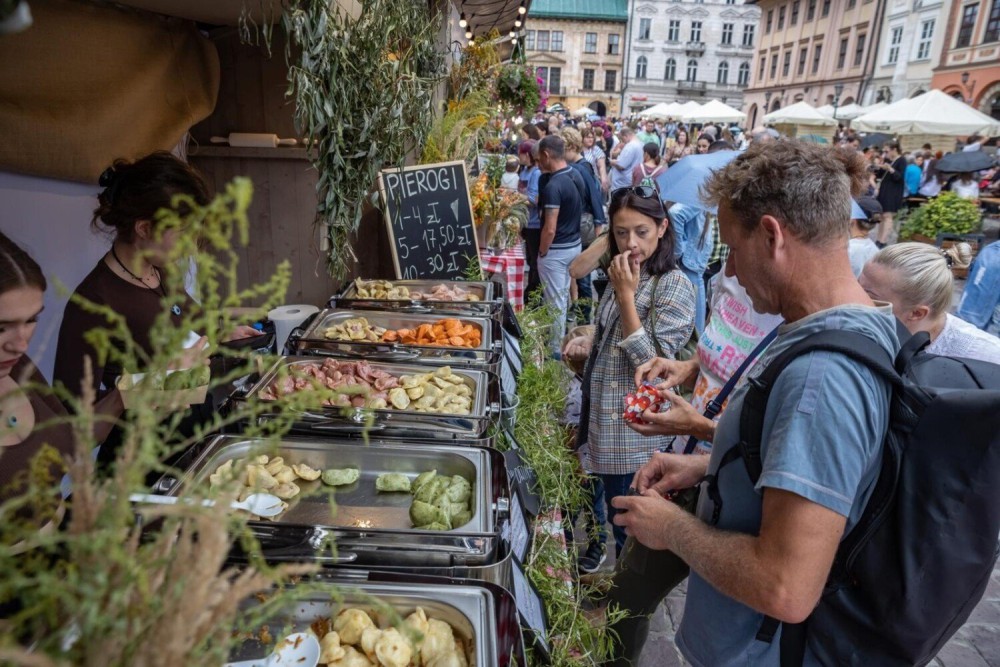
Top 5 polish cuisine restaurants in Krakow
1. Pod Aniolami: Located in the heart of the Old Town, Pod Aniolami offers a traditional Polish dining experience with a menu that includes classic dishes such as pierogi (dumplings), żurek (sour rye soup), and bigos (hunter's stew).
2. Miod Malina: Situated in a historic building near the Main Market Square, Miod Malina is known for its cozy atmosphere and a menu that showcases Polish specialties like oscypek (smoked sheep cheese), placki ziemniaczane (potato pancakes), and various meat dishes.
3. Polskie Smaki: This restaurant prides itself on serving authentic Polish cuisine made from locally sourced ingredients. Polskie Smaki offers a diverse menu that highlights traditional dishes like barszcz (beetroot soup), kaczka po krakowsku (Krakow-style duck), and gołąbki (stuffed cabbage rolls).
4. Wierzynek: With a history dating back to the 14th century, Wierzynek is one of the oldest and most prestigious restaurants in Krakow. While it offers a blend of Polish and international cuisine, it's renowned for its elegant atmosphere and high-quality traditional Polish dishes.
5. Starka Restaurant: Situated in a beautifully restored cellar, Starka Restaurant offers a contemporary twist on Polish cuisine. Alongside traditional dishes, they also feature modern interpretations of Polish favorites, showcasing the rich flavors of the country's culinary heritage.
Top 5 Kazimierz district Restaurants
1. Ariel: Located in the heart of Kazimierz, Ariel is a kosher restaurant that serves traditional Jewish dishes. It offers a cozy atmosphere and a menu featuring classics like matzo ball soup, gefilte fish, and kreplach.
2. Miodova: Situated in a historic building, Miodova is a restaurant that combines Polish and Jewish cuisine. They offer a range of dishes such as pierogi, latkes, and challah bread, alongside specialties like roasted goose or duck.
3. Plac Nowy 1: This restaurant is known for its unique setting in a former meat market building. Plac Nowy 1 serves modern Polish cuisine with Jewish influences. Their menu includes items like herring tartare, borscht, and slow-cooked beef cheeks.
4. Alchemia od Kuchni: Alchemia od Kuchni is a trendy restaurant located in the heart of Kazimierz. It offers a fusion of flavors from different cuisines, including Polish and Middle Eastern. Their menu features dishes like falafel, lamb chops, and Polish-style beef stroganoff.
5. Klezmer-Hois: Nestled in the Jewish quarter, Klezmer-Hois is a traditional Jewish restaurant with a lively atmosphere. They serve kosher dishes like cholent (slow-cooked meat and bean stew), kreplach soup, and a variety of Jewish-style grilled meats.
Top 5 Old Town Restaurants
1. Pod Nosem: Located near the Main Market Square, Pod Nosem is a refined restaurant known for its elegant atmosphere and Polish cuisine with a modern twist. Their menu features dishes like roasted duck breast, grilled Polish trout, and homemade pierogi.
2. Wesele: Situated in a historic building, Wesele offers a traditional Polish dining experience in a charming setting. They serve hearty dishes like bigos, roasted pork knuckle, and a variety of Polish soups. Live folk music performances add to the ambiance.
3. Chata: This rustic restaurant serves Polish cuisine in a cozy, log cabin-like setting. Chata is known for its grilled meats, including succulent sausages, pork ribs, and beef steaks. Traditional Polish side dishes like sauerkraut and potato pancakes accompany the main courses.
4. Cyrano de Bergerac: Cyrano de Bergerac is a French-inspired restaurant located in the heart of the Old Town. They offer a mix of French and Polish dishes, including escargots, foie gras, and beef tenderloin. The elegant interior and attentive service make it a popular choice for special occasions.
5. Hawelka: Positioned in a historic building, Hawelka is a cozy restaurant specializing in Polish cuisine. They serve a variety of dishes, including pierogi, żurek, and Polish-style schnitzel. The warm and inviting atmosphere adds to the overall dining experience.
Top 5 Budget Restaurants in Krakow
1. Milkbar Tomasza: Located near the Main Market Square, Milkbar Tomasza is a traditional Polish milk bar serving affordable and hearty meals. They offer a variety of Polish dishes such as pierogi, soups, and traditional main courses. The self-serve cafeteria-style setup keeps prices low.
2. Bar Mleczny Kazimierz: This budget-friendly milk bar is situated in the Kazimierz district. Bar Mleczny Kazimierz serves traditional Polish dishes at affordable prices. You can find classics like pierogi, bigos, and potato pancakes, along with soups and other home-style favorites.
3. Koko & Roy: Koko & Roy is a small, cozy restaurant in the Old Town that offers affordable Asian fusion cuisine. Their menu features dishes like ramen, bao buns, and various rice bowls. The portion sizes are generous, and the prices are reasonable.
4. Chimera: Chimera is a popular vegetarian and vegan restaurant located near the Main Market Square. They offer a range of affordable plant-based dishes, including salads, sandwiches, burgers, and falafel. The restaurant also has a pleasant outdoor seating area.
5. Pizza Garden: If you're in the mood for pizza, Pizza Garden is a good option. They serve delicious and affordable pizzas with a variety of toppings. The restaurant is located near the Old Town and offers both indoor and outdoor seating.
Top 5 mid-range restaurants
1. Cyrano de Bergerac: Located in the Old Town, Cyrano de Bergerac offers a mix of French and Polish cuisine in an elegant setting. The menu features dishes like escargots, foie gras, and beef tenderloin. While it's more upscale than budget options, it provides good value for the quality of food and dining experience.
2. Starka Restaurant: Situated in a beautifully restored cellar, Starka Restaurant offers a contemporary twist on Polish cuisine. They serve traditional dishes with a modern flair, showcasing the rich flavors of Polish culinary heritage. The restaurant has a stylish interior and a welcoming atmosphere.
3. Pod Aniolami: Nestled in the heart of the Old Town, Pod Aniolami is known for its traditional Polish cuisine and charming ambiance. They serve classic dishes such as pierogi, żurek, and bigos. The restaurant has a cozy and rustic interior, perfect for a mid-range dining experience.
4. Miod Malina: Miod Malina is located near the Main Market Square and offers a cozy atmosphere and a menu that combines Polish and European flavors. They serve dishes like oscypek (smoked sheep cheese), placki ziemniaczane (potato pancakes), and various meat specialties. The restaurant has a warm and inviting ambiance.
5. Szara Kazimierz: Positioned in the Kazimierz district, Szara Kazimierz offers a modern and stylish dining experience. They serve a mix of Polish and international dishes made with locally sourced ingredients. The restaurant features a trendy interior and a vibrant atmosphere.
Michelin restaurants in Krakow
Bottiglieria 1881 - led by Przemysław Klima, is the first Polish restaurant to receive two Michelin Stars. It is a well-known establishment among Polish food enthusiasts, and in recent years, it has been gaining increasing popularity among international guests.
POLISH CUISINE
Polish cuisine is rich in flavors and traditions, characterized by hearty and comforting dishes that reflect the country's agricultural heritage and cultural influences. Here is an overview of Polish cuisine, its age, and history:
Polish cuisine is known for its diverse range of ingredients, including meats, fish, potatoes, grains, cabbage, mushrooms, dairy products, and various herbs and spices. The cuisine places an emphasis on natural and seasonal ingredients, and many dishes are prepared from scratch with traditional cooking techniques.
Traditional Polish dishes often feature hearty stews, soups, dumplings, and roasted meats. Common ingredients include potatoes, sauerkraut, beets, onions, dill, caraway seeds, and sour cream. Polish cuisine is also renowned for its rich selection of pastries, cakes, and desserts.
Polish cuisine has a long history that dates back centuries. It evolved through the influences of various cultures and historical events that shaped the region. Some key milestones include:
1. Medieval Period: Polish cuisine began to take shape during the Middle Ages when Poland was a kingdom. The cuisine of this era was based on local ingredients such as game, freshwater fish, grains, and vegetables. The royal court played a significant role in the development of Polish cuisine, introducing exotic spices and ingredients from distant lands.
2. Renaissance and Baroque Eras: During the Renaissance and Baroque periods, Polish cuisine became more elaborate and refined. The nobility embraced French and Italian culinary influences, leading to the introduction of new flavors, cooking techniques, and lavish banquets.
3. Partitioning of Poland: The partitioning of Poland in the late 18th century resulted in the country losing its independence and being divided among neighboring powers. This period had an impact on Polish cuisine as the country's culinary traditions continued to develop within the context of foreign influences.
4. Post-World War II: After World War II, Poland went through a period of reconstruction and political changes. Despite the challenges, traditional Polish dishes remained important in everyday life, emphasizing simplicity, affordability, and the use of local ingredients.
5. Modern Polish Cuisine: In recent years, there has been a renaissance of Polish cuisine, with a renewed focus on traditional recipes and techniques. Chefs and restaurateurs have been incorporating modern twists and innovative presentations while staying true to the roots of Polish gastronomy.
Polish cuisine has been shaped by factors such as historical events, cultural exchanges, and the agricultural resources of the region. It continues to evolve while retaining its deep-rooted traditions, making it an essential part of Poland's cultural heritage and a source of pride for its people.
Typical polish meals
Polish cuisine is known for its hearty and flavorful dishes that reflect the country's agricultural heritage and traditional cooking methods. Here are some typical Polish meals you can expect to find:
1. Pierogi: Pierogi are dumplings made from unleavened dough and filled with various ingredients. Common fillings include mashed potatoes, cheese, meat, mushrooms, and fruits. They are typically boiled and served with melted butter, sour cream, or fried onions.

2. Bigos: Bigos, also known as hunter's stew, is a traditional Polish dish made with sauerkraut, fresh cabbage, and a variety of meats, such as sausage, bacon, and often beef or game meats. It is cooked slowly to allow the flavors to meld and is often enjoyed during festive occasions.
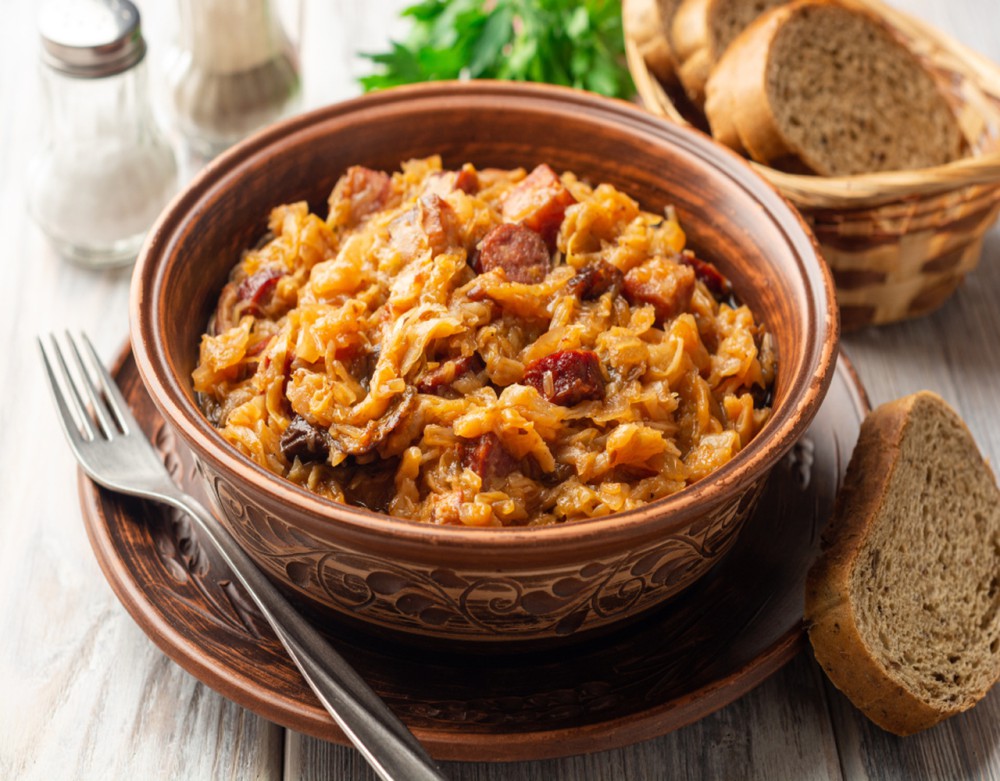
3. Żurek: Żurek is a sour rye soup that is a staple in Polish cuisine. It is made from fermented rye flour and typically includes sausage, potatoes, mushrooms, and hard-boiled eggs. The soup has a tangy flavor and is often served with a dollop of sour cream.
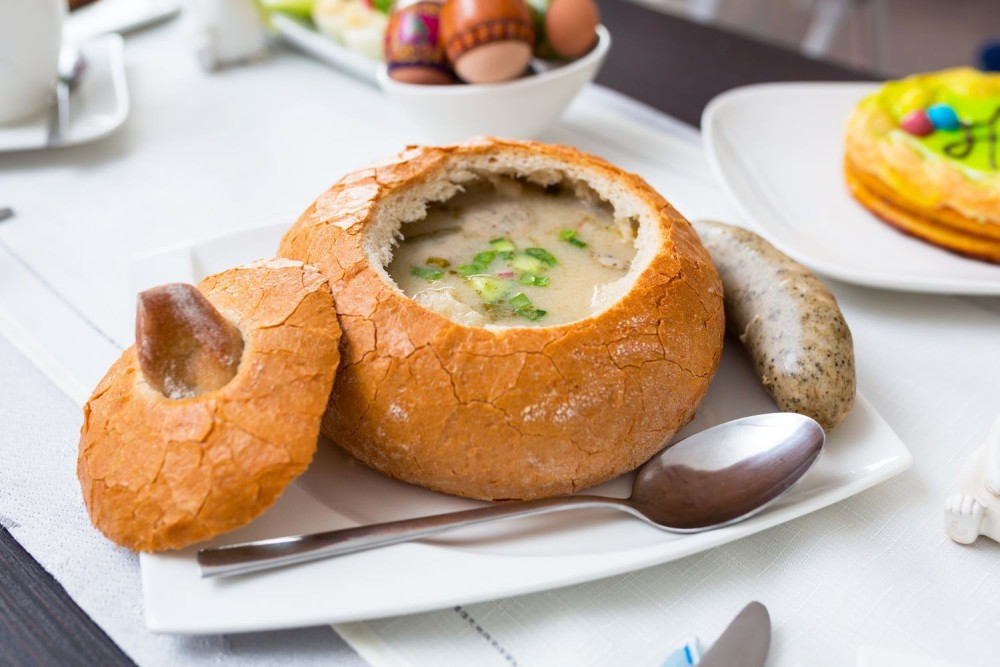
4. Gołąbki: Gołąbki are cabbage rolls stuffed with a mixture of ground meat (usually pork or beef) and rice or buckwheat. The rolls are baked or simmered in a tomato-based sauce until tender and served with mashed potatoes or a side of sauerkraut.

5. Golonka: Golonka is a portion of pork meat that includes the lower part of the shoulder bone and upper arm bone. This meat has become the basis for a dish of the same name, which reigns on both German and Polish tables.
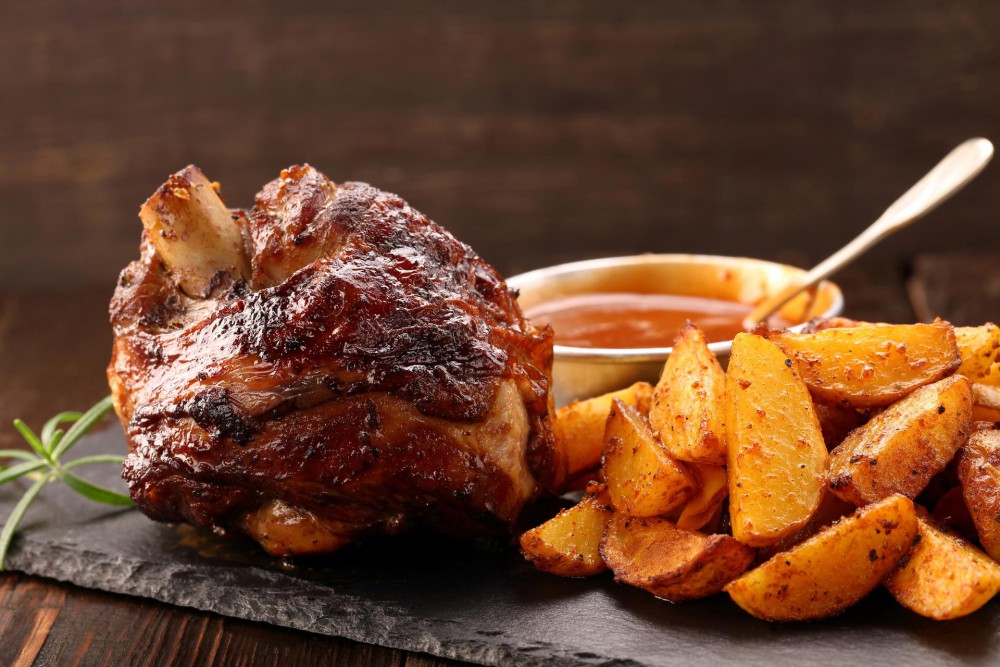
6. Kotlet schabowy: Kotlet schabowy is a breaded pork cutlet that is similar to a Wiener Schnitzel. It is made by coating a boneless pork chop in breadcrumbs and frying it until golden and crispy. It is typically served with boiled or mashed potatoes and a side of sautéed vegetables.
7. Barszcz z uszkami: Barszcz is a traditional beetroot soup that is often served with small dumplings called uszka. Uszka are similar to mini-pierogi and are usually filled with a mixture of mushrooms and onions. The soup is usually garnished with a dollop of sour cream.
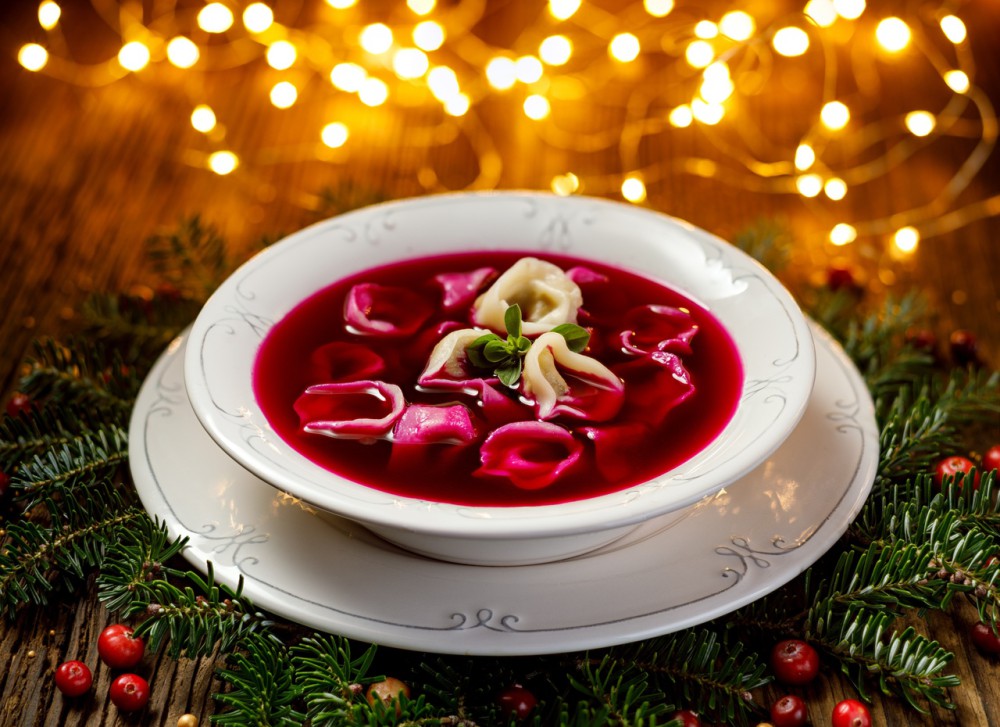
8. Makowiec: Makowiec is a poppy seed roll that is a popular dessert in Poland, especially during holidays. It consists of a sweet yeast-based dough rolled with a filling made from ground poppy seeds, honey, sugar, and sometimes nuts or raisins.

These are just a few examples of typical Polish meals. Polish cuisine offers a wide range of delicious and satisfying dishes, reflecting the country's culinary traditions and cultural heritage.
Typical Jewish meals ( Kazimierz district)
The Kazimierz district in Krakow, Poland, has a rich Jewish history and is known for its Jewish heritage. Traditional Jewish meals can be found in this area, offering a taste of Jewish cuisine. Here are some typical Jewish dishes you might find in the Kazimierz district of Krakow:
1. Gefilte Fish: A popular Jewish appetizer made from ground fish (commonly carp, pike, or whitefish) mixed with onions, matzo meal, eggs, and seasonings. It is traditionally served chilled.

2. Matzo Ball Soup: A comforting soup made with chicken broth, matzo meal dumplings, and vegetables like carrots and celery. Matzo ball soup is often served during Passover but can be enjoyed year-round.

3. Challah: A braided egg bread that is traditionally eaten on Shabbat (the Jewish Sabbath) and holidays. It has a slightly sweet taste and is often served as a side with meals or used to make French toast.

4. Latkes: Potato pancakes made from grated potatoes, onions, eggs, and flour or matzo meal. They are fried until golden brown and crispy, and typically served with sour cream or applesauce. Latkes are commonly enjoyed during Hanukkah.

5. Kugel: A baked casserole dish made with egg noodles or potatoes, eggs, sugar, and sometimes cottage cheese or sour cream. It can be sweet or savory, with variations including noodle kugel and potato kugel.

6. Blintzes: Thin pancakes filled with cheese or fruit (such as sweetened cottage cheese or blueberries), rolled up, and often topped with sour cream or fruit sauce. Blintzes are a delicious treat often served for breakfast or dessert.

7. Cholent: A slow-cooked stew typically prepared for Shabbat lunch. It consists of meat (such as beef or chicken), beans, barley, potatoes, and various vegetables, simmered overnight to create a hearty and flavorful dish.

8. Babka: A sweet yeast cake typically filled with chocolate or cinnamon swirls. It is often enjoyed for dessert or as a treat with coffee or tea.

These are just a few examples of the traditional Jewish meals you can find in the Kazimierz district of Krakow. Exploring the local Jewish restaurants and delis in the area will provide you with a wider range of authentic Jewish dishes to try.
How many days do you need to visit Krakow?
To fully experience and explore Krakow, it is recommended to spend at least three to four days in the city. This duration allows you to visit the major attractions, immerse yourself in the rich history and culture, and also have time for day trips to nearby sites.

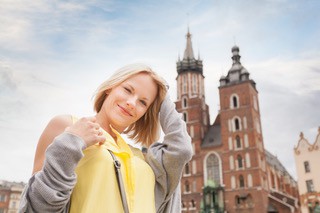
1. Is 3 days enough for Krakow?
Three days can provide a decent amount of time to explore Krakow and its major attractions. With three days, you can visit the historic center, including the Main Market Square, Wawel Castle, and St. Mary's Basilica. You can also explore the Kazimierz district, known as the historic Jewish Quarter, and visit sites like Oskar Schindler's Enamel Factory. Additionally, you can take a day trip to Auschwitz or the Wieliczka Salt Mine. While three days may feel a bit rushed, it is still sufficient to get a good overview of the city's highlights.
2. Is 2 days in Krakow enough?
Whether four days is too long in Krakow depends on your personal preferences and interests. Four days would allow you to explore Krakow at a more relaxed pace, taking your time to fully immerse yourself in the city's culture, history, and local atmosphere. It would also give you the opportunity to take additional day trips or explore lesser-known attractions. If you enjoy a more leisurely travel experience and want to delve deeper into Krakow's offerings, four days can be a reasonable duration.
3. Is 4 days too long in Krakow?
Two days in Krakow can provide a glimpse of the city, but it may feel somewhat limited in terms of time. With two days, you would have enough time to explore the main highlights of the historic center, such as the Main Market Square, Wawel Castle, and St. Mary's Basilica. You could also visit one additional attraction or take a half-day trip to a nearby site, like Auschwitz or the Wieliczka Salt Mine. While it may not be possible to cover everything Krakow has to offer in just two days, it can still be a worthwhile visit to get a taste of the city's atmosphere and main attractions.
4. Is Kraków a cheap city?
Kraków is generally considered an affordable city compared to many other European destinations. Prices for accommodation, food, and attractions are relatively lower compared to cities like Paris or London. However, keep in mind that prices can vary depending on the location and type of establishment.
5. How much is a pint in Krakow in pounds?
As exchange rates fluctuate, it's best to check the current conversion rates. On average, a pint of beer in Krakow may cost around 10-15 Polish złoty (PLN). At the time of writing, 1 British pound (GBP) is approximately equal to 5 PLN. Therefore, a rough estimate would be around £2-£3 for a pint of beer in Krakow.
6. How much is a pint of beer Krakow?
The price of a pint of beer in Krakow can range from approximately 10-15 Polish złoty (PLN), depending on the establishment and the type of beer you choose.
7. How much is a Coke in Krakow?
The cost of a Coke in Krakow can vary depending on where you purchase it. Generally, you can expect to pay around 5-10 Polish złoty (PLN) for a can or a bottle of Coke in a restaurant or cafe.
8. How ling is the train journey from Krakow to Auschwitz?
The train journey from Krakow to Auschwitz takes approximately 1 hour and 15 minutes. Trains run frequently between the two destinations, making it a convenient option for visiting Auschwitz.
9. Can you do Auschwitz in one day?
It is possible to visit Auschwitz in one day, but it's important to note that it can be emotionally intense and time-consuming. The Auschwitz-Birkenau Memorial and Museum consists of two main parts, Auschwitz I and Auschwitz II-Birkenau, and it is recommended to allocate several hours to explore both sections thoroughly. It is advisable to plan your visit in advance and consider guided tours or audio guides to enhance your understanding of the site's historical significance.
10. How much is a taxi from Krakow to Auschwitz?
The cost of a taxi from Krakow to Auschwitz can vary depending on the taxi company, time of travel, and other factors. As of now, a rough estimate for a one-way taxi ride from Krakow to Auschwitz is around 200-250 Polish złoty (PLN). It is advisable to negotiate the fare or use reputable taxi companies to ensure fair pricing.
11. How far is Krakow from airport?
Krakow has one international airport, John Paul II International Airport Kraków-Balice (KRK). The airport is located about 11 kilometers (7 miles) west of the city center. The journey from the airport to the city center takes approximately 20-30 minutes by car or taxi, depending on traffic conditions.
12. Is 5 days in Krakow too much?
Whether 5 days in Krakow is too much depends on your personal preferences and interests. Krakow offers a wide range of attractions, including historical sites, museums, vibrant neighborhoods, and nearby day trip options. With 5 days, you'll have plenty of time to explore the city at a leisurely pace, take day trips to places like Auschwitz or the Tatra Mountains, and also have some downtime to soak in the local atmosphere. It allows you to fully immerse yourself in the city's culture and history.
13. Should I visit Warsaw or Krakow?
Both Warsaw and Krakow have their own unique charm and attractions. Warsaw is the capital city of Poland and offers a more modern and cosmopolitan experience, with its contemporary architecture, museums, and vibrant nightlife. Krakow, on the other hand, is known for its well-preserved historical sites, beautiful Old Town, and rich cultural heritage. Ultimately, the choice between Warsaw and Krakow depends on your preferences. If you're interested in history and a more traditional atmosphere, Krakow might be a better fit. If you prefer a bustling capital with a mix of modern and historical elements, Warsaw could be the right choice.
14. Is a weekend enough for Krakow?
A weekend trip to Krakow can provide a taste of the city's highlights, but it may feel rushed to cover all the major attractions. With a weekend (2-3 days), you can explore the Old Town, visit Wawel Castle and Cathedral, experience the nightlife, and take a day trip to Auschwitz or the Wieliczka Salt Mine. However, to fully appreciate Krakow's rich history, cultural offerings, and neighboring attractions, a longer stay is recommended.
15. How much is a day trip to Auschwitz from Krakow?
The cost of a day trip to Auschwitz from Krakow can vary depending on the type of tour, transportation, and additional services included. On average, a guided tour with transportation from Krakow to Auschwitz can range from approximately 100 to 150 Polish złoty (PLN) per person. This price often includes entrance fees, a professional guide, and round-trip transportation.
16. What are the best months in Krakow?
The best months to visit Krakow are generally from May to September, as the weather is pleasant and conducive to outdoor activities. During these months, you can enjoy mild temperatures and longer daylight hours, which are ideal for exploring the city's attractions and taking day trips to nearby destinations. However, keep in mind that summer months (especially July and August) can be quite busy with tourists. Spring (April and May) and autumn (September and October) also offer pleasant weather and fewer crowds.
17. Is Krakow walkable?
Yes, Krakow is a highly walkable city, especially in the historic center. Many of the main attractions, such as the Main Market Square, Wawel Castle, and Kazimierz district, are within a comfortable walking distance from each other. The Old Town is pedestrian-friendly, with narrow streets and beautiful architecture, making it an enjoyable experience to explore on foot. However, public transportation options like trams and buses are also available if you prefer to cover longer distances or venture outside the city center.
18. Can you take food and drink into Auschwitz?
No, you are not allowed to take food and drink into the Auschwitz-Birkenau Memorial and Museum. As a place of remembrance and respect for the victims, visitors are requested to refrain from consuming food or drinks within the museum grounds. There are designated areas, such as the cafeteria, where you can have refreshments during your visit.
19. What city should I stay in to visit Auschwitz?
The city to stay in to visit Auschwitz depends on your preferences and travel plans. Krakow is a popular choice as a base for visiting Auschwitz, given its proximity to the site and the availability of convenient transportation options. Many tours and transportation services operate from Krakow to Auschwitz on a daily basis. However, if you prefer to stay closer to Auschwitz, the nearby town of Oswiecim is another option. It has a few accommodation options and is within a short distance from the memorial site.
20. How far is Krakow from Ukraine border?
The distance between Krakow and the Ukraine border varies depending on the specific border crossing. The approximate driving distance from Krakow to the nearest Ukraine border crossing at Medyka-Shehyni is around 315 kilometers (195 miles). However, please note that border regulations and crossing requirements can change, so it's advisable to check the most up-to-date information and ensure you have the necessary travel documents when planning a trip to the Ukraine border from Krakow.
21. Is Kraków an expensive city to visit?
Kraków is generally considered an affordable city to visit compared to many other European destinations. Prices for accommodation, food, and attractions are often lower than in cities like Paris or London. However, keep in mind that prices can still vary depending on the location, type of establishment, and tourist season.
22. Is it safe to walk in Krakow at night?
Krakow is generally considered a safe city to walk in at night, especially in the tourist areas. However, it is always advisable to exercise caution and be aware of your surroundings, as with any city. Stick to well-lit and populated areas, avoid isolated or poorly lit areas, and take common-sense precautions to ensure your safety.
23. Is it cheaper to eat in Krakow?
Eating out in Krakow can be more affordable compared to many other European cities. There are a wide variety of restaurants, cafes, and food stalls that offer reasonably priced options. You can find affordable local dishes as well as international cuisine at different price ranges to suit various budgets.
24. Is it better to stay in the Old Town in Krakow?
Staying in the Old Town of Krakow can be a great choice for tourists. It is a central and convenient location with easy access to major attractions, historic sites, and vibrant nightlife. The Old Town offers a unique atmosphere with its well-preserved architecture, cobblestone streets, and numerous restaurants, cafes, and shops. However, other areas of Krakow, such as Kazimierz or the Jewish Quarter, also have their own charm and may be preferred by some visitors.
25. Is Kraków more beautiful than Warsaw?
The beauty of Kraków and Warsaw is subjective and depends on personal preferences. Kraków is known for its well-preserved historical architecture, charming streets, and the UNESCO-listed Old Town. Warsaw, as the capital city, offers a mix of modern and historic elements with its contemporary architecture, vibrant cultural scene, and diverse neighborhoods. Both cities have their own unique attractions and beauty, so it's worth visiting both to experience their distinct characteristics.
26. Is Kraków a friendly city?
Kraków is generally known as a friendly city. Polish people, in general, are welcoming and hospitable towards visitors. Locals are often willing to help and engage in conversations, especially in tourist areas. English is commonly spoken in many establishments, and you should be able to communicate effectively in English during your visit.
27. What are the coldest months in Krakow?
Kraków is generally known as a friendly city. Polish people, in general, are welcoming and hospitable towards visitors. Locals are often willing to help and engage in conversations, especially in tourist areas. English is commonly spoken in many establishments, and you should be able to communicate effectively in English during your visit.
28. What are the do’s and don’ts in Krakow?
- Do try traditional Polish cuisine, such as pierogi (dumplings), bigos (hunter's stew), and oscypek (smoked cheese).
- Do respect local customs and traditions, especially when visiting religious sites.
- Do greet locals with a polite "Dzień dobry" (good day) and use basic Polish phrases like "dziękuję" (thank you).
- Don't drink alcohol in public spaces outside designated areas.
- Don't engage in excessive or disrespectful behavior at historical sites or memorials.
- Don't forget to validate your tram or bus ticket upon boarding public transportation.
29. Can you speak English in Krakow?
English is commonly spoken in Krakow, especially in tourist areas, hotels, restaurants, and attractions. Many locals, particularly those involved in the tourism industry, have a good command of English. You should be able to communicate effectively in English during your visit.
30. Which area to stay in Krakow for tourists?
The Old Town (Stare Miasto) and the surrounding areas, such as the Main Market Square (Rynek Główny), are popular areas for tourists to stay in Krakow. These areas provide easy access to major attractions, restaurants, and shops. Other recommended areas include Kazimierz, the former Jewish Quarter, known for its bohemian atmosphere, and Podgórze, which offers a quieter and more residential environment.
31. What is the wettest month in Krakow?
The wettest month in Krakow is typically July, with higher chances of rainfall. However, rain can occur throughout the year, so it's always a good idea to carry an umbrella or raincoat, especially during the spring and summer months.
32. What is the wettest month in Poland?
The wettest month in Poland can vary depending on the region. Generally, July and August are considered the wettest months in most parts of Poland. However, rainfall patterns can differ across the country.
33. When should I go to Krakow?
The best time to visit Krakow is generally during the spring (April to May) and autumn (September to October) seasons. These months offer pleasant weather, fewer crowds compared to the summer, and vibrant colors in the city's parks and landscapes. Summer (June to August) can be a popular time to visit, but it tends to be busier with tourists.
34. What is the best part of Krakow?
The best part of Krakow is subjective and can vary depending on personal preferences. The historic Old Town, with its Main Market Square, Wawel Castle, and St. Mary's Basilica, is often considered a highlight. The Kazimierz district, known for its bohemian atmosphere and rich Jewish heritage, is another favorite among visitors. Other notable areas include the Planty Park, Vistula River waterfront, and the vibrant nightlife scene.
35. What is Krakow best know for?
Krakow is best known for its rich history, stunning architecture, and cultural heritage. It is renowned for its well-preserved medieval Old Town, which is a UNESCO World Heritage site. Krakow is also recognized for being the former capital of Poland and has played a significant role in the country's history and development.
36. What alcohol is Krakow known for?
Krakow is known for producing and offering a wide range of alcoholic beverages. Vodka is one of the popular local drinks in Poland, with different varieties and flavors available. Krakow also has its own regional beer, often referred to as "krakowiak" beer, which can be found in local pubs and breweries.
37. Is Kraków good for drinking?
Krakow has a vibrant drinking culture, with numerous bars, pubs, and nightlife venues to explore. From traditional Polish pubs (piwnice) to trendy cocktail bars, there are options to suit various preferences. The city offers a mix of local and international beverages, and it can be a great place to enjoy a night out and try different drinks.
38. What money do you need in Krakow?
The currency used in Krakow and throughout Poland is the Polish złoty (PLN). It is advisable to have some Polish złoty on hand for smaller transactions and establishments that may not accept cards. Currency exchange offices and ATMs are readily available in Krakow.
39. Is it a good destination for a Krakow stag weekend?
Yes, Krakow is a great destination for a stag do. It is a vibrant and historic city with a lot to offer stag parties, including:
A lively nightlife scene with a wide range of bars, clubs, and strip clubs
Affordable prices for accommodation, food, and drink
A variety of activities to choose from, including shooting, go-karting, paintball, and white water rafting
A central location in Europe, making it easy to get to from most major cities
40. Is cash or card better in Poland?
Card payments are generally accepted and widely used in Poland, including Krakow. Major credit and debit cards, such as Visa and Mastercard, are commonly accepted in hotels, restaurants, and shops. However, it is still advisable to carry some cash, especially for smaller businesses or transactions.
WHAT IS KRAKOW BEST KNOWN FOR
1. What is Krakow known for?
Krakow is known for several things:
- Its rich history and architectural beauty, particularly in the well-preserved Old Town.
- The historic Wawel Castle, a symbol of Krakow's royal past.
- Its Jewish heritage, with the Kazimierz district being the historic Jewish Quarter.
- The Auschwitz-Birkenau Memorial and Museum, a significant site related to the Holocaust.
- Being a cultural and academic center, with prestigious institutions like Jagiellonian University.
- Its vibrant nightlife, with numerous bars, clubs, and live music venues and Stag Weekends.
- Delicious Polish cuisine, including dishes like pierogi and Polish sausages,
2. Why is Krakow unique?
Krakow is unique for several reasons:
- Its well-preserved historical sites, which provide an authentic glimpse into its past.
- The blending of different cultural influences, resulting in a diverse and vibrant atmosphere.
- Its significant Jewish heritage, reflected in the Kazimierz district and Jewish cultural events.
- The combination of historical landmarks, charming streets, and a lively local life.
- The city's intellectual and academic traditions, fostering a vibrant intellectual community.
- The legends and folklore associated with Krakow, adding to its unique character.
3. What is the legend of Krakow?
The legend of Krakow is associated with the mythical figure of the Wawel Dragon. According to the legend, a dragon terrorized the city, devouring livestock and threatening the residents. The King offered a reward to anyone who could slay the dragon. A clever shoemaker named Skuba fed the dragon a sheep filled with sulfur, which made the dragon incredibly thirsty. The dragon drank from the Vistula River until it burst. Skuba was hailed as a hero, and a statue of the Wawel Dragon stands near the riverbank as a reminder of the legend.
4. Is Kraków or Warsaw nicer?
Whether Krakow or Warsaw is nicer is subjective and depends on personal preferences. Krakow is known for its well-preserved historical sites, a charming Old Town, and a vibrant atmosphere. It offers a more compact and relaxed feel. Warsaw, as the capital, has a mix of modern and historic elements, with impressive architecture, a bustling city life, and a diverse cultural scene. Both cities have their unique attractions and charm, so it's worth considering your interests and preferences when deciding which one to visit.
WHERE IS BETTER KRAKOW OR PRAGUE?
1. Is Prague better than Krakow?
Whether Prague is better than Krakow is subjective and depends on personal preferences. Both cities have their own unique charm and attractions. Prague is known for its stunning architecture, including the iconic Prague Castle and Charles Bridge, as well as its rich history and vibrant nightlife. Krakow, on the other hand, is renowned for its well-preserved Old Town, Wawel Castle, and Jewish heritage. Both cities offer a range of cultural experiences and are popular tourist destinations. Ultimately, the choice between Prague and Krakow depends on your interests and what you're looking for in a travel experience.
2. Is it cheaper to go to Prague or Poland?
The cost of visiting Prague or Poland can vary depending on various factors, such as travel dates, accommodation choices, and individual spending habits. Generally, Poland, including cities like Krakow, tends to be more affordable compared to many Western European destinations, including Prague. Prices for accommodation, food, and attractions in Poland are often lower than in countries like the Czech Republic. However, it's advisable to research and compare prices based on your specific travel plans to determine which option may be more cost-effective for you.
3. What’s better Krakow or Budapest?
The comparison between Krakow and Budapest is similar to the comparison between Krakow and Prague. Both Budapest and Krakow have their unique appeal. Budapest is known for its stunning architecture, including the Hungarian Parliament Building and Buda Castle, as well as its thermal baths and vibrant nightlife. Krakow, as mentioned earlier, offers its own historical landmarks, Jewish heritage, and a more intimate atmosphere. Both cities have a rich cultural scene and provide a range of experiences for visitors. Choosing between the two depends on personal preferences and what you're looking for in your travel experience.
4. Is Prague worth going to?
Prague is certainly worth visiting for many travelers. It is often referred to as one of the most beautiful cities in Europe and offers a wealth of historical, architectural, and cultural attractions. The city's well-preserved Old Town, Prague Castle, Charles Bridge, and Astronomical Clock are just a few highlights. Prague also has a vibrant arts and music scene, renowned beer culture, and a variety of delicious Czech cuisine to enjoy. However, as with any destination, it's important to research and consider your own interests and preferences to determine if Prague aligns with what you're looking for in a travel experience.
BASIC POLISH GETS YOU THE RESPECT
Learning basic Polish phrases can be greatly appreciated and show respect when visiting Poland. While many people in tourist areas and younger generations may speak English, making an effort to communicate in the local language can enhance your interactions and make your stay more enjoyable. Here are some basic Polish phrases that can be useful:
1. Dzień dobry (jen doh-bri) - Good morning / Good day
2. Dobry wieczór (doh-bri vyeh-choor) - Good evening
3. Cześć (cheshch) - Hi / Hello
4. Proszę (pro-sheh) - Please / You're welcome
5. Dziękuję (jen-koo-yeh) - Thank you
6. Tak (tahk) - Yes
7. Nie (nyeh) - No
8. Przepraszam (psheh-prah-sham) - Excuse me / I'm sorry
9. Jak się masz? (yak shay mash) - How are you?
10. Nie rozumiem (nyeh roh-zoo-mee-em) - I don't understand
11. Gdzie jest...? (g-jeh yest) - Where is...?
12. Poproszę kawę / herbatę (pop-roh-sheh kah-veh / her-bah-teh) - I would like coffee / tea
13. Dziękuję bardzo (jen-koo-yeh bar-dzoh) - Thank you very much
14. Do widzenia (doh vee-dzen-ya) - Goodbye
15. Na zdrowie (nah zdroh-vee-eh) - Cheers / Bless you (when someone sneezes)
Remember, even attempting a few basic phrases can go a long way in showing respect and building connections with locals during your visit to Poland.